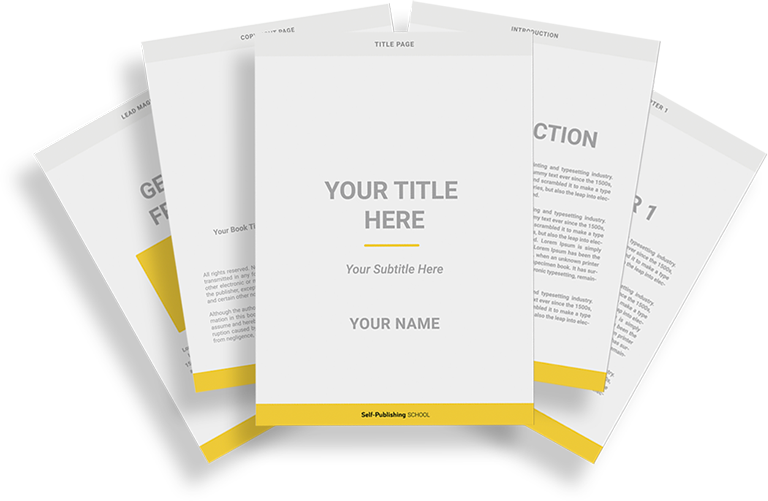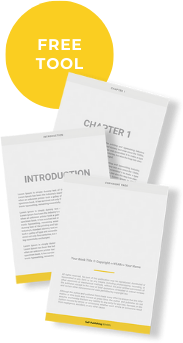Outlining. That word may conjure images of 7th-grade English, scribbling at your desk in frustration while a stern teacher looks over your shoulder. Many of us learned how to outline a book in middle school, and it’s a skill we haven’t revisited since our braces came off and the acne faded away.
Have no fear!
You’re a grown-up now, and this project isn’t being graded. You have free reign to learn how to outline a book in the way that benefits your writing process most—whether that’s a spaghetti-on-the-wall approach or a color-coded Excel spreadsheet.
Today I’ll teach out how to outline a book in 12 different styles, so you can choose what fits your genre and writing style best.


Book Outline Generator
Choose your Fiction or Nonfiction book type below to get your free chapter by chapter outline!
Book Outline Generator
Enter your details below and get your pre-formatted outline in your inbox and start writing today!
CONGRATULATIONS
Thanks for submitting! Check your email for your book outline template.
In the meantime, check out our Book Outline Challenge.

This blog on how to outline a book will cover:
Why should I learn how to outline a book?
No matter which type of book outline you choose, learning how to outline a book has many benefits. Outlining can help you define your goals, stay focused, and finish your manuscript more quickly.
You don’t need to spend huge amounts of time learning how to outline a book, but some (mostly painless!) prep before writing will be time well-spent since you won’t be spinning your wheels while staring at the blank screen of death.
Most nonfiction authors find outlines useful due to the nature of their books. Generally, writing nonfiction requires research and citation of sources (although many novels require their own research!) An outline can help organize your research so it doesn’t overwhelm you, plus your outline will help you create the best structure for your finished book.
For fiction authors, learning how to outline a book can help you to create a flawless story arc with dynamic, round characters.
When you start with a plan, you’ll unconsciously make connections and think about your draft, even when you’re not actively writing. Mentally writing in the shower is one of the perks of outlining, because it will get your thoughts percolating.
Be sure to keep paper and pens scattered about so you can capture your brilliance the minute it bubbles up, rather than letting all those ideas fade away.
Once you have a plan to write a book in outline form, you’ll be better able to put these thoughts to paper and compose your chapters when you do sit down to write. This means a finished book in less time.
So, I have some good news: there’s no “right” way to learn how to outline a book. Each writer will have their own process that’s personal to them. Keep reading for tips on how to outline a book in different ways. If one of these exact methods doesn’t strike a chord with you, you can combine methods to create your own way!
12 Options for How to Outline a Book
When learning how to outline a book, the method you take will probably rely on your genre. And, specifically, whether you are writing a nonfiction or fiction book.
We’re going to start with how to outline a book that is nonfiction. Then, we will move on to our tips for how to outline a book that is fiction. While there are plenty of relevant types you can apply to both types of books, learning how to outline a novel is inherently different from creating a nonfiction outline.
Regardless, we hope you read to whole list so you can determine which method (or mix of methods) is best for your unique book and writing process.
1. Mindmap + Book Outline
This is the main method of outlining that we teach in Self-Publishing School. The mindmap method requires you to create a brain dump based on your book’s topic.
Write your topic in the center of a piece of paper, then use lines and words to draw as many connections as you can. It doesn’t need to make perfect sense from the get-go—the goal is free-form thinking to get all of your ideas out of your head and onto the page.
You’ll start to notice connections between different categories of information. This makes it easier to spot the relevant “book-worthy” ideas. Then you can pluck those ideas out of your mindmap and put them into a cohesive book outline.
We also recommend creating a mindmap for each chapter you select from your original mindmap. It will help you structure your entire book chapter by chapter.
At Self-Publishing School, we encourage students to make a mess with their mindmap. Regardless of what your mindmap looks like in the end, it is an essential element to your book writing process. This mindmap will be the jumping-off point for you to begin your outline.
In this brief video, I explain how to easily turn your mindmap into an outline:
2. Chapter-by-Chapter Book Outline
Of course, mindmaps aren’t the only way to learn how to outline a book. You can also use a chapter-by-chapter book outline.
To get started, first create a complete chapter list. With each chapter listed as a heading, you’ll later add material or shift chapters around as the draft evolves.
Create a working title for each chapter, and list them in a logical order. After that, you’ll fill in the key points of each chapter. Finally, you’ll link your resources as they would appear in each chapter, including books, interviews, and Web links.
3. Sketch Your Book Outline
Perhaps you find the idea of a written outline confining. That’s OK — there’s another option which might appeal to your artistic side. Dan Roam, author of The Back of the Napkin: Solving Problems and Selling Ideas with Pictures, wrote about how sketching your ideas can simplify complex thoughts.
To learn how to outline a book in this method, hand-draw your book concept in sequential order. This may be as simple or as elaborate as you desire. Feel free to use a Bic pen and a spiral notebook, or take it to the next level with color medium on canvas-sized paper.
Others find satisfaction in sketching ideas with dry erase markers on a whiteboard, or the old-fashioned feel of chalk on a blackboard.
4. Book Outline With Scrivener
If you like being uber-organized, then the writing software Scrivener might appeal to you. Their book outline program allows you to upload your research and organize it by moving it around and filing it into folders.
The program does have a fairly extensive learning curve, which can be a major downside—especially if you tend to procrastinate and really want to get your book published quickly. However, some writers say it revolutionized their organizational process for longer works. There are so many perks and uses for Scrivener that most people find the learning curve worth it.
5. Post-It Wall

This is for the creative mind, and another method we teach in Self-Publishing School. All you need is a blank wall and a box of Post-It notes. Carry a pad of Post-Its with you wherever you go, and noodle your book on the fly. Write your ideas and inspiration on your Post-Its when the mood strikes you.
Next, affix the Post-Its containing words, snippets, doodles, and phrases to the wall. After a week of this exercise, organize these words into a book outline form. Voila! A simple, effective, and creative way to learn how to outline a book.
This often helps people who are writing braided essays. It can also work well for storyboarding a novel. For the rest of this list, I will be discussing the best methods for outlining a fictional novel.
Your novel outline will require character development, evolution of plot points, and resolution of conflict. While the methods for how to outline a book that is fiction may be different, the goal is the same—organization and pre-planning so that you can write a novel much faster.
6. Basic Document
Your goal with the Basic Document format is to use a Word or Excel table to give structure to your theme. Create a table and organize and summarize your key points and plot. You’ll then create a separate section for character sheets and themes, as well as an additional section with relevant research.
7. The Hero’s Journey
Oftentimes, the hero’s journey is not viewed as an outlining method; it’s mentioned more often in the context of how a character develops throughout a story. However, when you’re writing a character-driven story, it may be helpful to use this as an outlining method.
When you know this is the first challenge for the protagonist, this is the second, this is the third, and this is the climax, then you’re probably well on your way to outlining your novel.
8. The Snowflake Method
The Snowflake Method was created by fiction writing coach Randy Ingermanson based on the notion, “Good fiction doesn’t just happen. It’s designed.”
The process of the snowflake method focuses on starting small, and then expanding. For example, you’d start with one line from your book, then add a paragraph, then add a chapter. Since the snowflake method is fairly detailed and based on scientific theory, this article is worth a read so you can review the steps involved in this outlining method.
9. The Skeletal Outline
If you’ve ever written a term paper or thesis, then you’re probably familiar with the skeletal outline. You’ll lay out your narrative points in the order they’ll appear in your story, which involves a broad 7-step story arch. This gives you a big-picture idea of the flow of your story, so you can adjust your story and add subplots for maximum impact.
10. Three-Act Structure
The 3 act structure has been around since the time of Aristotle. It’s often used in films and plays because it’s easy to follow. Act 1 is set-up. Act 2 is confrontation. Act 3 is resolution. Not all sections are given equal time however, as the bulk of the book will be Act 2.
11. The Reverse Outline
Sometimes looking at the problem from a different angle can give you the answer to the question. The same applies to outlining. Reverse outlining is exactly what it sounds like: Write down how your novel ends. Then once you know the ending, outline backwards until you get to the beginning!
12. Novel Outline Template
Why reinvent the wheel? If you’re impatient to jump right into the fun part—writing!—or you aren’t sure exactly how to format your novel outline, then a pre-formatted template outline might be your saving grace. A fill-in-the-blank novel outline can help you develop your plot, characters, and ideas without getting bogged down with the notion of striving for “proper” outline form.
Luckily, we have a free novel outline template for you below, so you can get straight into writing your next bestseller.


Book Outline Generator
Choose your Fiction or Nonfiction book type below to get your free chapter by chapter outline!
Book Outline Generator
Enter your details below and get your pre-formatted outline in your inbox and start writing today!
CONGRATULATIONS
Thanks for submitting! Check your email for your book outline template.
In the meantime, check out our Book Outline Challenge.
